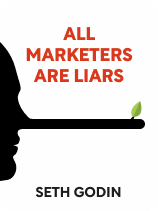

This article is an excerpt from the Shortform book guide to "All Marketers are Liars" by Seth Godin. Shortform has the world's best summaries and analyses of books you should be reading.
Like this article? Sign up for a free trial here .
What are the principles in the book All Marketers Are Liars? What is Seth Godin’s formula for successful marketing?
In All Marketers Are Liars (also titled All Marketers Tell Stories), Seth Godin argues that good marketing is spreading ideas through good storytelling. Everyone is a marketer because everyone has ideas to spread. Often, the story you tell about your idea is just as important as the idea itself. His principles of storytelling can be applied to product marketing, dating, politics, job hunting, and more.
Read on to learn the five principles presented in All Marketers Are Liars (All Marketers Tell Stories).
All Marketers Are Liars (All Marketers Tell Stories)
Godin is a writer, entrepreneur, marketer, and blogger. Published in 2005, All Marketers Are Liars (aka All Marketers Tell Stories) aims to improve your storytelling. His advice is helpful for people who are beginners or unfamiliar with the world of marketing.
Godin breaks down his ideas into five principles. Telling a good story first requires understanding worldviews and how consumers process information. Once you start thinking like a consumer, Godin says, you can tailor your story to make a good first impression. He then discusses avoiding the fine line between telling a story with a fib (stretching the truth in a way that resonates with the customer) and committing fraud. In the final principle, he talks about common marketing obstacles you may encounter, as well as how to overcome them.
New Marketing 101
When you hear the word “advertising,” what do you think of? If catchy jingles, milk carton ads, or TV infomercials come to mind, you’re probably thinking of outdated marketing techniques. Because advertisers traditionally addressed mass audiences, they succeeded by appealing mainly to people’s needs, and eventually, their wants. Often, companies spent a little on advertising, because their main focus was on increasing profit by cutting production costs. Godin argues that because of advances in technology, old marketing is outdated and ineffective.
(Shortform note: Some marketers believe old marketing isn’t completely obsolete. One marketing expert found that old marketing techniques like promotional gifts, coupons, and slogans are still effective. You should tailor your use of old-style advertising to your specific product and campaign.)
In All Marketers Are Liars (All Marketers Tell Stories), Godin takes a broader view of modern marketing in this book. Instead of thinking of marketing exclusively as trying to sell a product, he believes marketing is spreading ideas. He argues that you can market just about anything: products, services, job qualifications, religions, political candidates, and more. Which makes the marketplace—or all the different forums in which you can spread ideas—a pretty big place.
Additionally, new marketing places more focus on the consumer. According to Godin, new marketers must keep up with the constantly evolving marketplace and changing consumer demands. He therefore urges new marketers to understand that they are not in charge—customers are. Your customer will be a major influence on your marketing because you must tailor the ideas you’re spreading to customer feelings.
(Shortform note: Godin’s view of marketing as focusing on the spread of ideas to the consumer soon won converts in the industry. In 2008, the American Marketing Association (AMA) echoed Godin’s view when they updated their definition of marketing. The new definition described marketing as an educational process that benefits marketers, consumers, and society as a whole. This definition differs from the AMA’s previous one, which defined marketing as a function that delivers value to customers for the benefit of companies.)
The Power of Storytelling
Because people often buy based on emotion rather than need, Godin argues that it’s important for marketers to appeal to beliefs and feelings. This can involve lying by a certain definition. Godin defines lies as stories people tell themselves, which marketers build on. The consumer’s belief in a marketer’s lie makes it true—and our belief in how a product will make us feel is what we’re really buying. Therefore, he uses the terms lying and storytelling interchangeably.
(Shortform note: Godin says storytelling is one of the best ways to communicate with potential customers and address their beliefs and feelings. And because of an increasing amount of media options and consumption, there are more ways to tell complex, yet subtle stories about products. Podcast ads, YouTube ads, influencer sponsorships, email marketing, ads on blogs, social media marketing, and brand partnerships are just a few examples of the opportunities new media afford marketers.)
Principle 1: Appeal to a Worldview
Godin’s first principle of modern marketing is that a good story starts with a specific worldview. To be effective, your marketing story must jibe with your prospective customer’s worldview, the set of beliefs, values, and biases that determines how they see and interact with the world. While everyone has the same basic wants and needs (food, shelter, to be happy, healthy, and so on), Godin explains that their worldview determines how they fulfill them.
For example, consider the difference between someone on a Keto diet (which emphasizes consuming a high percentage of fat) and someone on a plant-based diet. Both people probably feel that they have found a dietary lifestyle that balances health and nutrition. Their different solutions to a common goal reflect different worldviews. When your marketing story not only addresses a customer need but also validates their worldview or beliefs, Godin believes the customer is more likely to use your product and keep coming back.
People with similar worldviews or beliefs often group into small niches or micro-communities. Godin says a marketer’s success lies in finding the right group of people with a shared worldview and telling them a compelling story that aligns with it. Godin warns that worldviews can change collectively or individually. If your customers’ worldview changes but your story doesn’t, you could quickly lose a big portion of your audience, so you should pay attention to your customers and social changes.
| Understanding and Changing Worldviews Stephen Covey’s 7 Habits of Highly Effective People suggests another way to define worldviews, which he calls paradigms. He defines paradigms as the lenses through which you see the world and that shape how you interpret your situations and surroundings. These interpretations dictate your behavior, much like Godin’s idea of worldviews influencing you to buy a product. Our sense of self is often tied to our worldview. We usually have an automatic, defensive response to information that threatens our worldview, and therefore, our sense of self. We also tend to dismiss facts that don’t conform to our worldview (also known as confirmation bias). This can be tricky to navigate as a marketer. So how do you do it? Covey offers an answer for how to change a perspective. He proposes becoming aware of your biases, identifying the worldviews you want to adopt, and shifting your perspective. While his writing is geared toward individuals wanting to adjust their worldviews, advertisers can tailor his ideas to their marketing story to thoughtfully address a worldview. Ask yourself: What bias are you addressing? How does your product answer that worldview? Does it offer a better solution or new reality? |
How to Appeal to a Worldview
Now that you know what a worldview is, how can you use that to tell a better story? How do you tell a story that doesn’t conflict with your customer’s worldview? In addition, how do you control the story around something that could be viewed as a negative? In All Marketers Are Liars (All Marketers Tell Stories), Godin says using three tools—frames, euphemisms, and oxymorons—can help you align your story with a worldview.
- Frames: According to Godin, framing is a way to leverage or influence someone’s worldview. It’s how you spin your story to encompass a worldview. Framing your story can give you some control over the customer’s initial impression of your product. For example, if you tell someone “the glass is half full,” they’ll look at it more favorably than if you tell them it’s half empty.(Shortform note: Godin’s idea is also known as the Framing Effect, where information is presented in different ways to achieve a desired perception. Common frames include avoiding risk, achieving a goal, and appealing to emotions.)
- Euphemisms: Euphemisms are different names for the same idea. They are used to steer attention away from negative connotations or biases someone may already have about a certain idea to help you frame your story in a more favorable light. For example, “adult beverages” replaces “alcohol” or “liquor” to avoid negative connotations. (Shortform note: Euphemisms can be helpful when marketing sensitive products, such as laxatives. However, when using euphemisms, don’t be misleading, obscure, or offensive.)
- Oxymorons: Similar to a euphemism, an oxymoron is a way to frame an idea by using contradictory words. By using oxymorons, you can use new words or phrases for an old concept in order to avoid negative connotations or to catch the consumer’s attention. You can target people who have two worldviews that seem like they’re at odds with each other. For example, “non-alcoholic beer” is an oxymoron because beer is, by definition, alcoholic. This phrasing appeals to someone who likes beer but doesn’t want the negative effects that come with drinking alcohol. (Shortform note: While oxymorons tend to be words or phrases, Godin also refers to ideas that confound expectations by surprising the reader with a contrast as oxymorons. His usage is similar to a juxtaposition, where two ideas are placed next to each other for a contrasting effect.)
Principle 2: Understand How Your Customer Thinks
Worldviews affect what information the customer takes in and how. Godin’s second principle of modern marketing explains how consumers process information and make what he calls snap judgments. Understanding your customers’ thinking can help you break through the noise of other products and catch your customer’s attention. Godin breaks down four steps customers go through as they make snap judgments in the marketplace:
- They notice change: Your customer will notice changes in their environment. As consumers, we’re bombarded with so much information that it’s necessary for us to disregard most of it. But if there is a change in our environment, we’re likely to notice it. (Shortform note: A 2004 study found that people are more likely to notice change they expect, like a red stop light turning to a green light. People are less likely to notice small, improbable changes, like cars changing lanes behind you on the interstate.)
- They make an assumption: Once your customer notices that something changed in their environment, they’ll make an assumption about why it changed. They’ll build their own story for why their environment is different. Usually, their worldview will shape these assumptions. Assumptions influence your consumer’s first impression of your product and can determine whether or not they’ll buy what you’re selling. (Shortform note: Another way to think of assumptions is in terms of consumer perception. Customer perception is how people select, organize, and interpret information they encounter. In The 22 Immutable Laws of Marketing, the authors describe how a consumer’s perception of a product is more important than the quality of the product. Therefore, your audience must believe that your product is the best option.)
- They predict what happens next: After noticing changes, customers will use their assumptions to predict what will happen next. Godin says this prediction helps them know what to expect next from their environment so they can pay attention for the next change. This is where consumers will build their own story about your idea or product and determine if they believe your lie. (Shortform note: Like marketers, politicians use people’s predictions to their advantage, allowing people to fill in the gaps of an idea with their own story. In Win Bigly, Scott Adams describes how Donald Trump’s presidential campaign focused heavily on building a wall. However, Trump was vague about the details of the wall. This allowed voters to fill in the gaps on how they thought the wall should be built, ultimately causing more people to attach to the idea.)
- They stick to the story: Finally, consumers will stick to the story they predict until another change forces them to repeat the cycle. People will stick to their story even when presented with facts that may contradict them since it’s hard for people to change their biases. (Shortform note: Godin references Blink by Malcolm Gladwell, who says there are two processes for arriving at a decision: conscious thinking and unconscious thinking. Conscious thinking is our logical (but less efficient) way of coming to conclusions. Unconscious thinking is our intuitive and quick way of parsing information—or snap judgment.)
Principle 3: Make a Good First Impression
As we saw in Principle 2, consumers frequently make snap judgments about people, products, food, stores, website design, dating profiles, and more. In All Marketers Are Liars (All Marketers Tell Stories), Godin argues that most people make their decision about something—such as whether or not they like someone, or if they want to buy that shirt—within moments of encountering it.
People’s tendency to make quick, lasting judgments means it’s important to make a good first impression about your product and company. Before we talk about how to do this, let’s dissect what Godin means by first impressions and how they’re different from first encounters.
Impressions vs. Encounters
A customer’s first encounter is their initial introduction to your product. They may walk into your store on a whim or click on your website by accident. However, the first encounter may not cause them to engage with your story. And if it doesn’t engage them, they’ll disregard their first encounter as they interact with other options in the marketplace. In contrast, Godin contends that when you successfully grab the customer’s attention at an encounter, you create an impression that leads them to make a snap judgment about your idea or product. That’s why first impressions are important for a marketer—it’s your best (and sometimes only) opportunity to get through to a customer.
(Shortform note: Color plays a big role in a customer’s first impression. In a 2006 study, researchers discovered that up to 90% of snap judgments about products are based on color. Your choice of color can influence mood, appetite, and even perception of time spent waiting.)
While first impressions are important, Godin says it’s also just as important to remember that the first encounter won’t always lead to a customer’s first impression. Since not every encounter will turn into an impression, the best you can do as a marketer is make sure that no matter what encounter they have, it’s a good one. That way, when it does eventually make an impression on them (and Godin assumes that an impression will happen eventually), it’ll be a favorable one. He argues that to ensure good encounters—and by extension, good impressions—every way you incorporate your story into your marketing should be perfect—or as close as you can get. How? Godin gives two answers:
1) Be authentic. Tell a story that aligns with your company, the product itself, and brand identity. This could be a story about luxury, family, beauty, or comfort—just be sure this story is true to the overall ethos of your idea and brand. (Shortform note: How do you align your story with your company values? In Start With Why, Simon Sinek discusses the importance of defining your mission as a company and why you’re doing what you’re doing in business. That way, you have a clear set of values that will authentically guide your stories.)
2) Be cohesive: Because you don’t know if a customer’s first (or second or third) encounter will be their first impression, it’s best to cover your bases and incorporate your authentic story into every possible encounter. If you tell an authentic story across all potential encounters, you’re more likely to make a good first impression. Godin says all departments are part of the marketing department. If the president of your favorite company used a competitor’s products, would that change your perception of their products?
(Shortform note: In Godin’s view, your goal in marketing is to turn strangers into friends and friends into customers. To turn strangers into customers, try making a marketing plan. In The 1-Page Marketing Plan, Allan Dibs believes good marketing can be broken down into three phases: attention, familiarity, and enthusiasm. Generate interest by identifying your target audience, developing the message you’ll tell that audience, and figuring out what medium you’ll use to tell them that story. Then design a process that will help your customer get familiar with your company, like signing up for email notifications or putting a product in their cart. Get your lead’s contact information into a database, deliver value, and build their trust. Then focus on continually giving them a great experience, for instance with great customer service)
Godin believes personal interactions are the best way to foster authentic relationships with consumers. This could come from a recommendation from a friend, a pleasant interaction with an employee, or a friendly phone call. He recommends you ditch the script and connect with your customers. Good personal interactions cut through the gimmicks and create lasting impressions.
(Shortform note: In Raving Fans, Ken Blanchard and Sheldon Bowles describe how creating better customer service experiences can help companies succeed. They say the key to happy (not just satisfied) customers is through this five-step plan: define your ideal customer service experience, discover your customer’s ideal experience, integrate your vision with their needs, build an effective and consistent system, and always exceed customer expectations.)
Principle 4: Tell a Believable Story
As we discussed earlier, marketers are selling the story, not the product. People buy a product because of how that story makes them feel, not because of logic. And if you’re marketing to a worldview, you’ll be telling your story to people who want to listen. This leaves room for marketers to exploit consumers and how they feel about a product’s story.
When marketing, you shouldn’t exploit consumers with your storytelling. In All Marketers Are Liars (All Marketers Tell Stories), Godin urges marketers to know the difference between telling a “fib” and committing fraud—and to never commit fraud.
Fibs
Godin defines a fib as a story that may not be 100% factual or based in reality. Fibs are used to appeal to a customer’s feelings. But if a fib is believed, it doesn’t cause any harm to the customer, and it enhances your product. Godin notes that it’s okay to fib parts of your story—bending the truth here and there in a way that benefits both you and your customer. If you tell a fib and your customer believes it, it becomes true.
(Shortform note: The Federal Trade Commission (FTC) and Institute for Advertising Ethics (IAE) are two organizations that distinguish the line between fibs and frauds. Both organizations echo Godin’s claim that products should not cause harm to the consumer. This includes physical, psychological, and financial harm. When appropriate, scientific evidence should be cited to back up advertising claims. The IAE also notes that it should be clear to consumers that they’re viewing an advertisement—in other words, don’t masquerade your ad as news or editorial content.)
Godin uses Georg Riedel as an example. Riedel is a glassblower who specializes in wine glasses. People—even those in the wine-tasting community—insist his glasses improve the taste of the wine. Riedel’s story (that a good wine deserves a luxury vessel for a better tasting experience) aligns authentically with his product (handcrafted wine glasses). People believe that wine tastes better in a Riedel glass, despite no factual evidence to back this up. Their belief in the product improves their experience drinking wine, so the story benefits both Riedel and his customers. It’s a common fib in the wine-tasting community that the right wine glass can improve the taste of wine.
(Shortform note: There may not have been much research on the topic at the time of the book’s initial publication in 2005. However, more recent studies show that there may actually be a correlation. One Japanese study supports the idea that glass shape influences taste, while another study shows that visual perception influences taste.)
Frauds
When you abuse the consumer’s potential to be exploited, Godin says you’re committing fraud. Telling a story that benefits only you and not the customer is fraud. Whereas a customer’s belief in a fib makes it true, a customer’s belief in fraud doesn’t make it true. Fibs can enhance your product, while fraud hides the fact your product isn’t as good as you’re claiming it is. When a customer discovers fraud, they’ll feel betrayed, and it will be difficult to regain their trust.
(Shortform note: The title of Godin’s book is misleading, and some readers expressed their confusion about it. Marketers are liars in the sense that they are fibbing or stretching the subjective truth of their story, but they are not making objectively untrue statements, advertising harmful claims, or lying to the point of deceit or fraud. So marketers aren’t really liars by the usual definition, just storytellers or fibbers.)
For example, women’s wellness brand Goop faced a lawsuit over claims their “vaginal eggs” could balance hormones and regulate menstrual cycles. They also claimed their “flower essence” would cure depression. These claims were not scientifically backed and caused harm to customers who believed this story, resulting in a $145,000 settlement.
Principle 5: Use Obstacles to Tell a Better Story Next Time
You now understand the characteristics of an effective story, the difference between fibs and frauds, and why you should never commit fraud. This section discusses common obstacles you’ll run into as a marketer and how to use them to your advantage. First, we’ll tackle how to handle competitors. Then, we’ll identify where you might have gone wrong if your product didn’t do as well as you thought it would.
How to Handle Competition
Competition in the marketplace fosters creativity and innovation. Unless you create an entirely new industry, you’ll no doubt have to deal with competitors and their stories. If someone is already telling a good story, how do you survive in the marketplace? In All Marketers Are Liars (All Marketers Tell Stories), Godin presents a few ways to handle competition:
- Tell a similar story in a different market: If you’re having trouble finding a place to start, Godin recommends telling a story similar to one someone else is already telling in a different market.
- Tell a better story for a different worldview: If you’re entering or competing in a market where someone else is already succeeding with their story, don’t try to tell their story better. Tell a completely different story.
- Tell a story to a niche within an existing worldview: If you’re entering a competitive market, you can also try to narrow down an existing worldview. In other words, find a niche, and then find a niche within that niche.
- Tell a story to an evolving worldview: Because worldviews are so susceptible to change, this gives you the opportunity to adapt your marketing stories or even guess how current ones may change.
| Determine Your Competitors By identifying who is and is not a competitor, it’ll be easier for you to determine where to look for inspiration and when to appeal to a different worldview. As you develop your marketing for a product, it’s important to position yourself within the marketplace and identify your friends and foes. Consider completing a competitor analysis by examining your competition, what works for them, and the different kinds of stories they’re telling. Competition can fall into three categories: Primary competitors: When you hear “competitors,” the first companies or people that come to mind are probably your primary competitors. They target a similar product or service to your audience. Wendy’s and McDonald’s are primary competitors. Secondary competitors: These companies offer similar products to a different audience, or they offer a similar product of greater or lesser quality. For example, Tiffany is a secondary competitor to Kay Jewelers. Both sell jewelry but for different audiences and at different price points. Tertiary competitors: These competitors are loosely related to your company or industry. They don’t pose much of a threat unless they decide to expand into your market. Gatorade and Under Armour are tertiary competitors because they’re loosely related by the worldview they address (one that values athletic excellence). But unless Under Armour decides to create a line of sports drinks, they don’t pose a threat to Gatorade. |
How to Interpret Failure
You’ll no doubt encounter some bumps in the road on your marketing journey. Let’s say you’ve used Godin’s tips, and you think you’ve got a great product to market. Godin outlines four common problems that can occur:
- Your target customers didn’t pay attention: If you had a great product and a great story, they probably just didn’t notice it among all of the other products and information vying for their attention. (Shortform note: If you’re having trouble getting your customer’s attention, try Donald Miller’s advice in Building a StoryBrand: Explicitly tell your customer what value your product offers them.)
- They weren’t interested: If someone noticed your product but didn’t try it, you may not have addressed the right worldview with your story. Or you may not have told your story using the language that people with this worldview expected to hear. Or your story didn’t compel them to change their bias that favors another product. (Shortform note: In his chapter in Tools of Titans, Godin advises marketers to start by telling 10 interested people about your new idea or product. They should be people you trust, who trust you, and who would probably love your new product. They could be friends or people who follow your blog. If they like it, they’ll find other people to tell, and your product will spread; if they don’t, you should probably spend some time rethinking your product.)
- They didn’t like it: If someone noticed your product, tried it, and didn’t like it, your product probably didn’t address the problem or worldview like you thought it would. This has more to do with the product itself than the marketing. (Shortform note: There’s a popular phrase in marketing: “Nothing kills a bad product faster than good marketing.” Good marketing generates consumer attention, but if the product doesn’t work, that attention will quickly turn to how bad the product is. That means your great marketing story won’t save a product that doesn’t work, so you shouldn’t completely disregard the quality of your product.)
- They didn’t tell anyone: Does everyone who tries your product like it? If someone noticed your product, tried it, liked it, but didn’t tell anyone, they may not have felt compelled or comfortable talking about your product, and you need to find out where you went off track. (Shortform note: Godin is open about the importance of setbacks and failure, stating entrepreneurs who fail often are more likely to succeed. In a blog post about how to fail better, he advises that whenever you fail, take ownership of it, and identify exactly where you went wrong. That way, you won’t make the same mistake twice. Also, never blame someone else for your failure.)

———End of Preview———
Like what you just read? Read the rest of the world's best book summary and analysis of Seth Godin's "All Marketers are Liars" at Shortform .
Here's what you'll find in our full All Marketers are Liars summary :
- The difference between lying and telling a great story
- How to better understand your customer
- How to overcome common obstacles you’ll encounter in marketing






